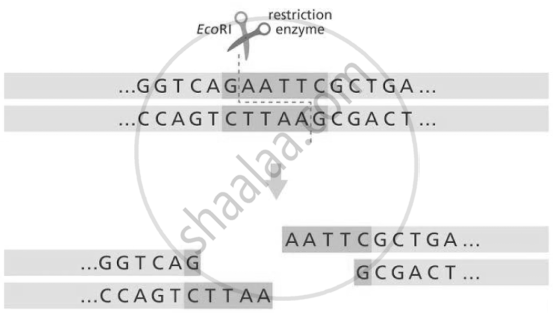Advertisements
Advertisements
प्रश्न
'EcoRI' has played a very significant role in rDNA technology.
- Explain the convention for naming EcoRI.
- Write the recognition site and the cleavage sites of this restriction endonuclease.
उत्तर
(I) Restriction endonucleases are named as follows:
1st alphabet represents the genus of the organism from which the enzyme is isolated.
2nd and 3rd alphabet represent the species of the organism.
4th alphabet represents the strain.
The Roman number represents the order of isolation or discovery of the enzyme.
EcoRI comes from the Escherichia coli RYB strain.
In EcoRI, 'E' comes from the genus 'Escherichia' and 'co' comes from the species name 'Coli'.
The letter 'R' is derived from the name of the strain RYB.
Roman numbers following the names indicate the order in which the enzymes were isolated from that strain of bacteria.
(II) The recognition sequence where EcoRI cleaves the DNA molecule is G/AATTC. Such sequences have a complementary sequence, CTTAA/G, which is known as a palindromic sequence.

APPEARS IN
संबंधित प्रश्न
Why is the enzyme cellulase needed for isolating genetic material from plant cells and not form the animal cells?
Do eukaryotic cells have restriction endonucleases? Justify your answer.
Collect 5 examples of palindromic DNA sequences. Better try to create a palindromic sequence by following base-pair rules.
Explain briefly:
Restriction enzymes and DNA
Answer the following question.
Write the use of restriction endonuclease in the formation of recombinant DNA.
The total number of nucleotide sequences of DNA that code for a hormone is 1530. The proportion of different bases in the sequence is found to be Adenine = 34%, Guanine = 19%, Cytosine = 23%, Thymine = 19%.
Applying Chargaff’s rule, what conclusion can be drawn?
There is a restriction endonudease called as EcoRI. What does co part in it stands for?
What does H in’ ‘d’ and ‘III’ refer to in the enzyme Hind III?
How does one visualise DNA on an agarose gel?
How are DNA fragments visualised once they are separated by gel electrophoresis?
